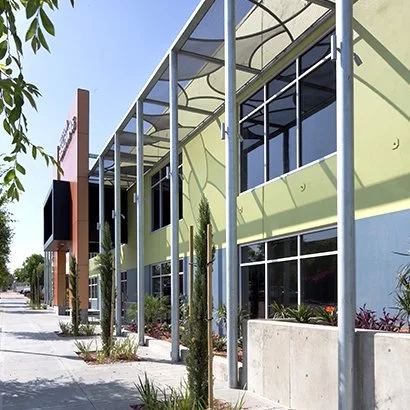SUSTAINABLE DESIGN
We believe that the best value is derived from a building using durable materials that require low maintenance. Consequently, we typically avoid using wood framing, except in renovation work; we prefer steel and concrete masonry as our primary structural materials. We fully expect our buildings to last 80-100 years, based on the European model. High quality construction techniques derive from using high quality materials. For example, all of the exterior flashing and sheet metal at the Coronado Animal Care Facility is copper, because the building is sited next to the bay; this material will be durable and long-lasting in that environment without maintenance. Our core values are based upon respect for the communities in which we work, along with trusteeship of our environment.
LEED / COLLABORATIVE FOR HIGH PERFORMANCE SCHOOLS / SAVINGS BY DESIGN
LEED is much more than a checklist for us. Early in design, we address issues of sustainability because green design is engrained in our firm’s culture and core values. All new structures in California are mandated to be Zero Net Energy by 2030. Buildings can achieve Net Zero Energy (NZE) performance by employing natural lighting and ventilation strategies, high performance envelopes, and highly efficient HVAC equipment and photovoltaic (PV) energy generation. We have completed two LEED Gold projects: La Jolla Country Day School Kindergarten Center (2009), and the Coronado Animal Care Facility (2010). LEED certification is pending for Camp Ronald McDonald. The Monarch School and Camp Cuyamaca are both LEED certified. These two Gold level certifications were achieved without PV use, but rather through common sense design, to receive innovative design credits. Our firm includes LEED Accredited Professionals who ascribe to the U.S. Green Building Council’s (USGBC) LEED Online V.3 system to manage, coordinate, and track project certification and commissioning.
As a firm of LEED Accredited Professionals, we work to achieve optimum project solutions in the quality of spaces, durability of materials and systems, and reduction of water and energy consumption. We balance aesthetics, functionality, ease of maintenance, indestructability, and cost effectiveness throughout our design and construction process. We’re fond of saying, “Our buildings should solve problems, not create new ones!”
-

Coronado Animal Care Facility: LEED GOLD
-

La Jolla Country Day School Kindergarten Center: LEED GOLD
-

Monarch School: LEED Certified
EMBODIED CARBON
Embodied carbon refers to the total greenhouse gas emissions associated with the extraction, manufacturing, transportation, and construction of building materials, as well as their eventual demolition and disposal, rather than from their daily operation. It includes the environmental impact of producing materials like steel and concrete and is a major component of the overall carbon footprint of buildings and infrastructure. Tools like life cycle assessments (LCAs) and databases of environmental product declarations (EPDs) are used to measure and reduce embodied carbon.
The energy data provides the energy consumed to make a building material. This then gives rise to embodied carbon emissions, contr...
Zero Net Energy (ZNE) means that over a year, a building produces as much renewable energy on-site as it consumes in energy from the grid. This balance is achieved by minimizing energy consumption through high-efficiency design and equipment, and by generating renewable energy, typically through solar panels. The goal of ZNE buildings is to reduce energy costs, minimize environmental impact, and improve occupant satisfaction, according to the Department of Energy.
